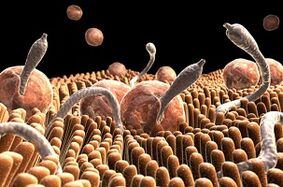
Helminth infection is possible even in our civilized society. These parasites invisibly enter the body and poison it with the products of their vital activity. Helminth secretions are toxic and cause a variety of diseases - from hives to serious health problems. There are also fatalities.
Common Symptoms of Worm Infection Helminths live not only in the human intestines, some types of parasites infect other organs, and may even be present in skeletal muscle. Therefore, the course of each helminthiasis has its own characteristic signs, but there are still general symptoms:- reduced performance;
- rapid fatigue;
- dehje;
- weakness;
- drowsiness;
- lack of appetite;
- weight loss;
- joint pain;
- constipation;
- bowel disorder;
- intolerance to any type of food.
Alas, but many people are infected with parasites, some do not even know it. Eggs or cysts can be swallowed with seemingly clean food. Often, worms settle on a child's body, dealing with poorly washed fruits and vegetables, through dirty hands, by cats and dogs. The problem is that there is often no doubt that someone else lives in us, as there are types of parasites that do not manifest for a long time. Therefore, it is worth knowing better about worms, what types exist and what symptoms of infection they cause.
Human roundworms
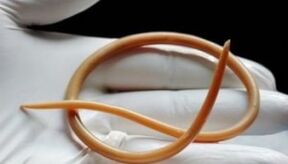
Sting worms, roundworms, worms and Trichinella (rarely) can live in the human body.
Roundworms are round worms with a fusiform body, 15-40 cm long and 4-6 mm wide. This helminth lives in the small intestine, although there are cases where roundworms crawl into the bile ducts and block them. Inside males, females mate with males and lay eggs, which, along with the feces, come out.
A person is not infected with roundworms that live in animals.
Next, the eggs need to be baked in the ground. If they enter the human body with unwashed fruits or vegetables, the larvae are excreted in the intestine, they quickly penetrate the blood vessels and reach the lungs with blood flow. There, the larvae mature and migrate to the intestine through the trachea and oral cavity. And there new individuals have already blossomed and everything repeats itself. Roundworms live up to 14 months.
With ascariasis, appetite decreases, there is nausea, diarrhea, intestinal pain, allergic manifestations. Sleep is also disturbed, irritability appears. When you migrate from the lungs, there may be a cough. With the accumulation of ascaris and the formation of a ball of them, intestinal blockage can develop.
Stake worms are small, white worms 3-12 mm long. Needle worms live in the small and large intestines. In summer it is very easy to get infected with these helminths, it is enough not to wash your hands, or you can even swallow the helminth eggs by sucking the dust. Female worms lay eggs in the anus, causing severe itching. The eggs of the worms are so small that they can even be inside the rising dust.
You can become infected through linen, hygiene items, food, handshakes, etc. Adults live in humans a little, only 1-2 months and with proper hygiene, they can be disposed of within a short time. In addition to itching, there are: insomnia, lack of mind, irritability, allergic rash.
Vlasoglavs are slender worms that live in the large intestines and reach a length of 30-35 mm. You can be infected with parasites in the same way as roundworms. Vlasoglavs attach to the intestinal wall and suck blood. Toxins released by them cause headaches, poor sleep, dizziness and nausea. The lifespan of helminths is 5 years.
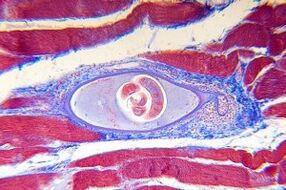
Trichinella are small worms, only up to 4 mm long. A person becomes infected through live pork, which contains larvae. Adults live in the gut, mate and lay eggs, after which they die. Trichinella larvae are secreted, they penetrate from the intestines to the muscle tissue, where they form a capsule and can stay for years.
Helminthiasis causes the following disorders in the body:
- swollen face;
- eyelid edema;
- swelling of feet and hands;
- skin rash;
- muscle pain;
- fever, fever;
- headache;
- insomnia or, conversely, drowsiness;
- reduced mobility of the knee and elbow joints;
- gastrointestinal disorders are observed.
Trichinosis is partially cured, as if adult worms can be destroyed with medication, then the larvae in the skeletal muscle cannot be killed.
Ribbons in humans
- Cattle barcan be up to 10 m long. Infection occurs when you eat poorly cooked beef, which contains helminth larvae. Housewives can become infected by tasting raw minced meat with salt. In the body, a tapeworm develops from the larva, which lives in the intestines, clinging to the wall in order to be held. A person loses weight, loses appetite, experience dizziness, insomnia, nausea and often vomiting.
- The pig stripis smaller, reaching only 2 m. Infection occurs after you have eaten poorly processed pork. The symptoms are the same as with bovine tapeworm.
- Wide striphas a length of 6 m to 15 m. The source of infection is raw freshwater fish. Helminthiasis is manifested by weakness, nausea, vomiting, drowsiness, abdominal pain, constipation or diarrhea. There are always painful bright red spots on the tongue and even cracks.
- The dwarf striphas a length of 3-5 cm. They are infected with this helminth through contaminated door handles, toilet seats, if they have worm eggs. Children get sick more often. Helminthiasis causes decreased appetite, nausea and abdominal pain, and sometimes diarrhea. In rare cases, children may have seizures similar to epileptic seizures.
- Echinococcusis one of the most dangerous helminths. Infection occurs in dogs and cats - carriers of adult parasite individuals. In the human body, the larvae hatch from eggs, which are transported by the bloodstream to various organs, most often the liver, where they form echinococcal cysts. In some cases, they even reach the size of a newborn baby's head. Cysts are removed only with surgery.
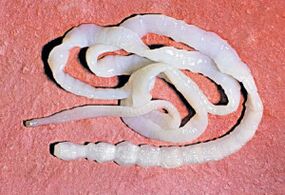
human suckers
- Flukeparasitizes the bile ducts and the gallbladder itself. The size of helminths is small - 4-13 mm. The parasite enters the body through the use of slightly salted or poorly cooked (fried) fish. First, this helminthiasis is manifested by a high temperature (up to 40 degrees), pain in the joints and muscles, disorders of the gastrointestinal tract, in rare cases, jaundice develops. Then the acute symptoms fade, there is paroxysmal pain in the pancreas. There may be complications.
- Fasciolais dangerous to health. The worms are up to 3-7 cm long, and also settle in the gallbladder and biliary tract. A person becomes infected through boiled water or by eating aquatic plants. Weakness, fever, headache and abdominal pain, urticaria appear.
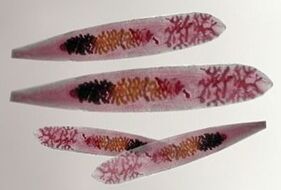
Conclusion about human helminths
Some types of worms live for years in the human body, as they can hardly appear in any way. Often, the symptoms of helminthiasis are similar to diseases of the gastrointestinal tract, so a misdiagnosis is made unless special tests are done to identify helminths. But you urgently need to get rid of any parasites, as they not only get beneficial substances from the body, but also release toxins dangerous to health.
























